Brocket Hall in Yorkshire
Brocket Hall—now consisting only of a double moated site, but well preserved and identified as the best surviving moated site in North Yorkshire—lies at the east end of Appleton Roebuck, c 6 m SSW of York City centre.1
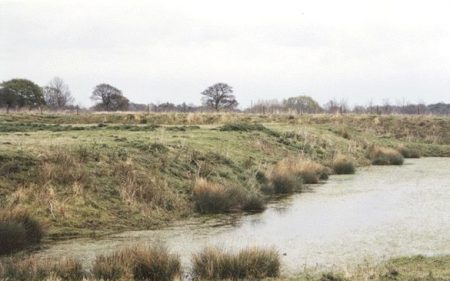
Part of Brocket Hall Moat looking east
The manor house itself occupied much of the south side of the rectangular moat enclosure in the first photo below.2 The extension to the moat west and south-west served as fish ponds. The size of the moat enclosure can be appreciated by comparing it to the neighbouring two-storied detached houses:
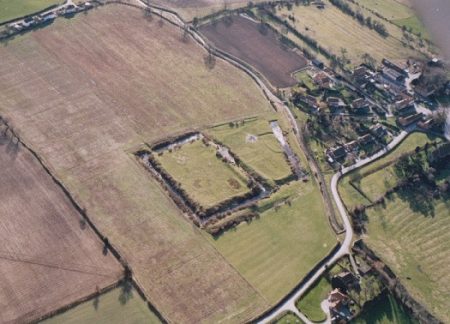
Aerial view looking south west—3 Mar 1991 © 2006 Aeroscene Ltd
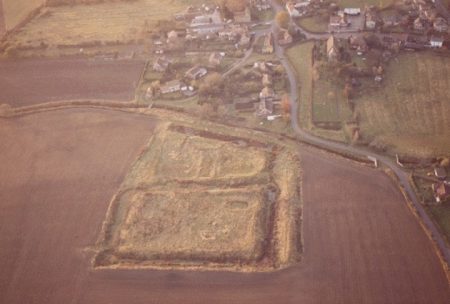
Aerial view looking west—17 Nov 1985 © 2006 Aeroscene Ltd
The ancient ridge and furrow formations in the surrounding fields are evident. As they are in the following sketch plan of the site by archaeologist Richard Cross supplied in a lecture in Nov 1981:3
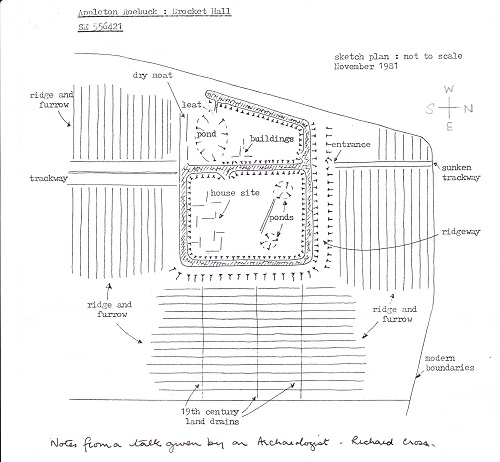
Brockethall Yorkshire plan view
Nowadays a closely planted wood abuts hard up against the ridgeway surrounding the moat. Cross’ sketch also shows that the manor house occupied much of the south side of the rectangular moat enclosure.
Historic England, under Reasons for Designation, says:4 “The moated site at Brocket Hall is well preserved and has been identified as the best surviving moated site in North Yorkshire. As there are no modern buildings on the interior the below-ground remains of medieval buildings on the eastern island will be well-preserved while the accuumulated silts of the moat ditch and associated fishponds also favour the survival of evidence which would assist the study of the medieval environment and the economy of the site.” Its Details begin “The monument includes a moated site known as Brocket Hall which lies to the south-east of Appleton Roebuck village. It is a double moated site in that it comprises two adjacent moated islands. The eastern island is interpreted as the site of the hall, since fragments of stone, tile and medieval pottery have been found there; the island is rectangular, measuring 85m long and 55m wide and is surrounded by a ditch 3m wide and up to 2m deep.” Le Patourel mentioned “Indications of foundations on E. Enclosure. Banks on both sides of deep moat. Fragments of stone, tile and mediaeval pottery from enclosure.”5 Also a 2002 Review report of Appleton Roebuck Conservation Area refers to it as Brocket Hall.6
Beyond referring to its medieval characteristics, neither source speculated about its date. Harrison, the late historian of Bolton Percy/Appleton Roebuck, sensibly suggested that the moat may have first been dug by the Fauconbergs in the 2nd half of the 12th C,7 a time when Wharram Percy was also flourishing, see below. But what might the manor house or hall itself have looked like?
The manor house
Over time it of course would have been renovated, added to and even rebuilt, but for the 12th C Harrison continued that it “would no doubt have held a large timber framed house, a gate house and other buildings. It had a huge platform and was capable of housing the entire population [of Appleton] and their stock if necessary during the troubled times of the 12th and 13th century.”8 This looks accurate apart from the timber frame to the hall, which is anachronistic. It was perhaps caused by Harrison’s view that the hall would probably have looked like the gatehouse near the Church,9 which is timber-framed but no doubt 16th C, see below.
Some 32 miles NE of Bolton Percy was the related Percy settlement of Wharram Percy which “flourished between the 12th and early 14th centuries, when members of the noble Percy family lived in the village.”10 This is a reconstruction of its main manor house:11

According to Dr David Andrews, archaeologist and Fellow of the Society of Antiquaries, who worked on the excavation of the Wharram Percy site in the 1980s, “The normal components of a 12-13th C manorial site were a chamber over a cellar, and a grand semi-private residential space at first floor. There should have been an open single storey hall as well, which is what we could not find. Bolton Percy would very probably have had them as well as other buildings such as a kitchen.12
The charming depiction of the Hall in this snip from Jeffrey’s 1596 map of Bolton Percy,13 appears similar to the Wharram Percy manor house above, but this will probably be coincidence—the map’s representation of the shape of the moat enclosure and the Hall’s position in it appear to be inaccurate and stylised. The catalogue description says, “Buildings are shown in crude elevation.”14
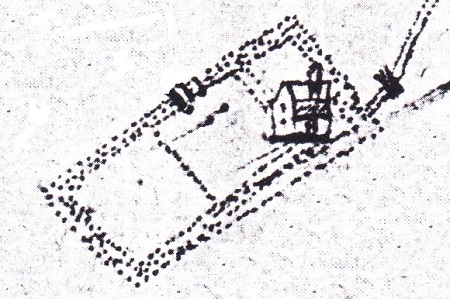
At any rate, 1596 was nearly two centuries after the initial Broket occupation and renovation of Brocket Hall and it may well have needed renovation again by the 16th C. The new owners may have done so in a style more like that of contemporary oak-framed houses in York City,15 and the oak-framed 16th C gatehouse near the Church:16
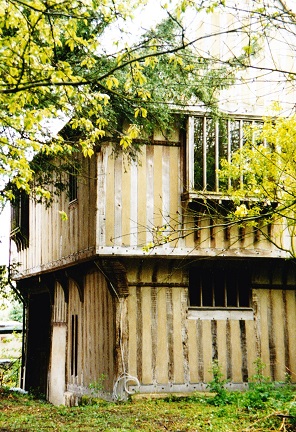
An early 20th C local historian wrote:
“Brockett Hall is a goodly moated site at the head of Daw Lane—of rectangular form, and divided in the centre by a deep trench and rampart, each space measuring within the inner bank about one hundred and twelve yards by sixty.”17
The manor’s earliest recorded name was Southwood Manor18 and would have become known as Brockethall at some stage after Thomas Broket inherited it by marriage to the heiress Dionisia Sampson. Deriving its name—and Brocket Hagg‘s—simply from the late Middle English word broket meaning a red deer in its 2nd year unconvincingly misses out this surname stage, 19 see the separate page.
Thomas appears to have rebuilt or extended the manor house, perhaps inserting a storey into the single medieval hall open to the rafters.20 The Abbot of Selby paid him 60 ash trees c 1401 for pleading on his behalf as his attorney in the court of the Exchequer, see the separate page. The next entry in the Abbot’s accounts shows the same number of trees being given to a prior at York to renovate a house.
Brocket Hall probably started to decay as the Broket family focussed their attention mainly on their lands in Hertfordshire. It was sold by Sir John Brockett II of Herts to Thomas Fairfax of Nun Appleton, son of Sir William, in 1565. Guy Jefferson, a yeoman farmer, and probably the steward or bailiff of the Fairfax lands in Appleton, lived at Brocket Hall in the 1590s and the last known occupant was Thomas Fairfax of Nun Appleton’s son Charles in 1602, whereafter the buildings decayed.21 The principal local residence of the main Fairfax family was Steton, see the separate page. “The very survival of these impressive earthworks [at Brockethall] indicates yet another migration of the seignorial residence elsewhere.”22
Page Last Updated: November 8, 2023
[1] This photo of the moat below is licensed under the Creative Commons Attribution-NonCommercial-ShareAlike 4.0 International License. See the Copyright page of this Broket Archive. To view a copy of this license, visit goo.gl/n1oUFq (accessed 13 Sep 2020) or send a letter to Creative Commons, PO Box 1866, Mountain View, CA 94042, USA.
[2] Cross 1981.
[3] Probably the Richard Cross who worked as the Canterbury City Council Archaeological Advisor till about 2014.
[4] https://tinyurl.com/y3qzkpdv (accessed 24 Sep 2020), most recently amended 13 Sep 1993.
[5] 1973 p 122.
[6] Section 2.3 at https://tinyurl.com/y3co5hpz (accessed 24 Sep 2020).
[7] M J Harrison 2000 p 71.
[8] M J Harrison 2000 p 71.
[9] Oral communication, Jun 2000.
[10] https://tinyurl.com/yynqsv4n (accessed 25 Sep 2020), its English Heritage website.
[11] Beresford and Hurst 1990 p 126.
[12] Email communication 24 Sep 2020 from Dr David Andrews, IHBC (member of the Institute of Historic Building Conservation) FSA.
[13] See Le Patourel 1973, Plate IV A, and p 122.
[14] Borthwick Institute for Archives PR/BP/15, see https://tinyurl.com/y4c7a6v2 (accessed 25 Sep 2020).
[15] Palliser 1979 p 31.
[16] This photo below of Bolton Percy gatehouse is © Adrian Brockett 2000-20 and licensed under the Creative Commons Attribution-NonCommercial-ShareAlike 4.0 International License. See the Copyright page of this Broket Archive. To view a copy of this license, visit goo.gl/n1oUFq (accessed 13 Sep 2020) or send a letter to Creative Commons, PO Box 1866, Mountain View, CA 94042, USA.
[17] Bogg 1902 p 294.
[18] M J Harrison 2000 pp 70, 75, 192, 257.
[19] A H Smith 1961-2 pt 4 p 220.
[20] Palliser 1979 p 34.
[21] M J Harrison 2000 pp 84, 92, 99.
[22] Richard Cross lecture 1981 p 4.

